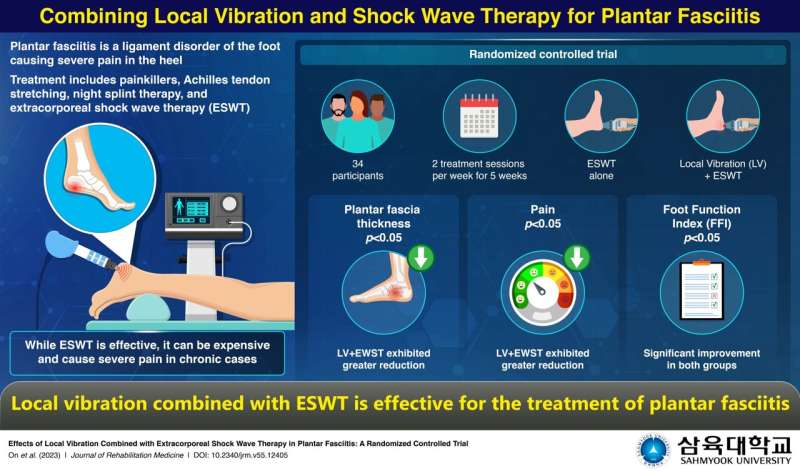This article has been reviewed according to Science X's editorial process and policies. Editors have highlighted the following attributes while ensuring the content's credibility:
fact-checked
proofread
Healing heel pain: Researchers explore the use of local vibration in plantar fasciitis treatment

Plantar fasciitis (PF) is a common musculoskeletal, inflammatory condition, characterized by severe pain in the heel of the foot, to the extent that it limits day-to-day activities. The plantar fascia ligament, a fibrous connective tissue, supports the arch of the foot and functions as a shock absorber, similar to modern-day car suspension systems. With increased activity, the ligament can experience tears and damage, leading to the development of PF.
Treatment for PF includes pain management through anti-inflammatory drugs, stretching exercises, night-splint therapy, steroidal medications, and extracorporeal shock wave therapy (ESWT). While ESWT has proven to be beneficial and effective in reducing heel pain, it is expensive and has adverse effects such as increased pain sensitivity, especially in chronic cases of PF.
To this end, a team of researchers led by Dr. JongEun Yim, Associate Professor of Physical Therapy and Director of the Active Aging Research Center at Sahmyook University in Seoul, South Korea, explored the use of local vibration (LV) in combination with ESWT to treat PF. Their research findings were published in the Journal of Rehabilitation Medicine.
Explaining the motivation behind the present research, Prof. Yim says, "PF is a common and painful orthopedic ailment affecting many individuals. However, there are limited therapy options available at present. This motivated me to study novel PF treatment options that can be more effective and contribute to improved patient outcomes."
Interestingly, their study revealed the combination of local vibration and extracorporeal shock therapy as an effective approach for treating chronic plantar fasciitis.
The team conducted a randomized controlled trial involving 34 participants who were divided into two treatment groups. One group received a combination of local vibration (LV) and ESWT, while the other group underwent ESWT alone.
Parameters were assessed at the beginning and end of a 5-week treatment period, including ultrasonography to track plantar fascia thickness and a questionnaire to evaluate plantar-heel pain and foot function. The results indicated that using the LV and ESWT combination was more effective and significant in reducing the thickness of the plantar fascia and heel pain.
"LV devices are portable, inexpensive, and reduce pain after PF treatment. This study highlighting the novel combination approach may help to establish a treatment protocol for the PF condition," concludes Prof. Yim.
In summary, this study captures a novel therapeutic intervention to treat PF and reduce the burden of heel pain.
More information: HyoJeong On et al, Effects of local vibration combined with extracorporeal shock wave therapy in plantar fasciitis: a randomized controlled trial, Journal of Rehabilitation Medicine (2023). DOI: 10.2340/jrm.v55.12405

















